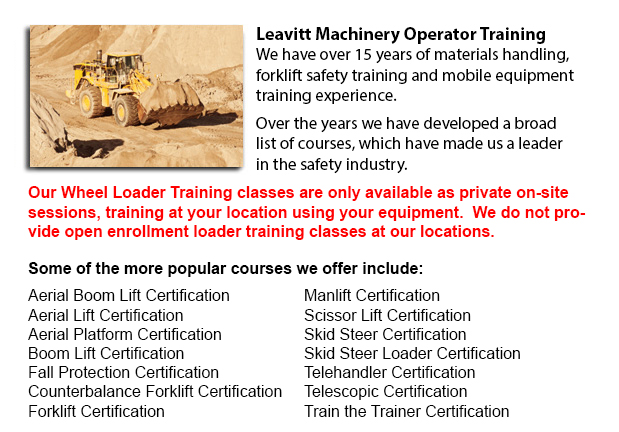
Wheel Loader Operator Training British Columbia - Cranes are industrial machines that make use of levers or pulleys to raise significant cargo. The Roman people used cranes so as to build huge monuments, which means these machinery have been present for at least 2,000 years. Numerous Medieval churches used cranes in their construction and the Egyptians may have relied on them when constructing the pyramids.
New cranes can either be simple or complex, based on the nature of the function they could do. For instance, mobile cranes are rather simple models. A steel truss and even a telescopic boom mounts its movable platform. A system of levers or pulleys lifts the boom and there is often a hook suspended. These cranes are normally used for demolition or earthmoving by changing the hook out with one more piece of device like for instance a bucket or wrecking ball. Telescopic cranes have a series of hydraulic tubes which fit together to form the boom. These models can even be mobile.
Both specialized or traditional wheels could be used for railroad track or caterpillar track enabling these boom trucks to move on upaved and uneven surfaces.
Rough terrain and truck mounted cranes are mobile as well. Outriggers are positioned on the truck mounted unit to improve stability, while rough terrain cranes include a base which tends to resemble the bottom of a 4-wheel drive. These cranes are equipped in order to work on uneven surface making them ideal in the construction trade for example.
Usually used on ports and in railroads, the Gantry crane can move and unload large containers off ships and trains. Their bases have huge crossbeams which run on rails to be able to raise containers from one place to another. A portainer is a unique type of gantry which transfers supplies onto and off of ships specifically.
Floating cranes are mounted on pontoons or barges and are one more essential piece of machinery vital to the shipping industry. In view of the fact that they are places in water, they are meant for various services consisting of port construction, building bridges and salvaging ships. Floating cranes could handle very heavy cargo and containers and like portainers, they could even unload ships.
Loader cranes comprise hydraulic powered booms that are fitted onto trailers to be able to load stuff onto a trailer. The jointed parts of the boom can be folded down whenever the machinery is not in being utilized. This particular type of crane could be also considered telescopic in view of the fact that one section of the boom could telescope for more versatility.
Normally used in automated warehouses, stacker cranes tend to follow an automatic retrieval system and could work by remote. These cranes are equipped with a forklift apparatus and can be found in big automated freezers, stacking or obtaining foodstuff. Utilizing this kind of system allows staff to remain out of that freezing environment.
Tower cranes are frequently the tallest cranes and normally do not have a movable base. They have to be put together piece by piece. Their base is similar to a long ladder with the boom at a 90 degree angle to the base. These cranes specialize in the construction of tall buildings and are often connected to the inside of the building itself through the construction period.
-
Warehouse Forklift Safety Training British Columbia
Warehouse Forklift Safety Training British Columbia - The corporation would face claims for liability when damage and injuries are sustained in an accident at the workplace. Warehouses can be a hazardous place to work for its workers, making employee... More -
Loader Operator Certification British Columbia
Loader Operator Certification British Columbia - Courses Offered For Getting Loader Operator Certification - Certification for forklifts are required to guarantee the safe operation of forklifts for those employers in industrial, warehouse or constru... More -
Crane / Overhead Crane / Self-Erect Crane / Truck Mounted Crane / Hydraulic Cranes Training in British Columbia
Bridge cranes or likewise called overhead cranes are actually a type of industrial material handling crane making use of a line and hook device that runs on a horizontal beam running along two widely separated rails. Numerous overhead cranes could be... More -
Scissor Lift License British Columbia
Scissor Lift License British Columbia - The operation of scissor lifts carries an inherent chance of danger. Whichever type of powered machine requires correct handling to prevent accidents causing injury or damage. Companies need to make certain tha... More -
Heavy Equipment Training Schools British Columbia
Heavy Equipment Training Schools British Columbia - There are a lot of heavy equipment training schools to select from. If you want to get to the best, it is important to check various aspects of the school in order to ascertain the level of educatio... More -
Telehandler Training British Columbia
Telehandler Training British Columbia - Telescopic handlers usually called telehandlers for short, are an extremely popular piece of heavy construction equipment. They are commonly utilized in the construction and agricultural trades. These machines... More -
Forklift Training Courses British Columbia
Forklift Training Courses British Columbia - When forklift operator safety training is tailored for illiteracy, training time is lessened by 50%. Forklift training certification, lift-truck operator driver safety training evaluation, and train the tr... More -
Heavy Equipment Operator Training British Columbia
Heavy Equipment Operator Training British Columbia - Heavy equipment operator training facilities which provide quality standards in the business, providing field performance work and added machinery training are highly sought after training features... More

Forklift Training British Columbia
TOLL FREE: 1-888-254-6157
forklifttrainingbritishcolumbia.com
Email Us
About Us


